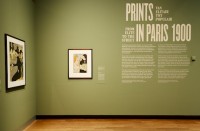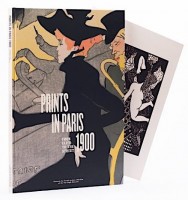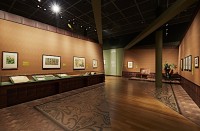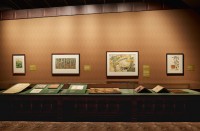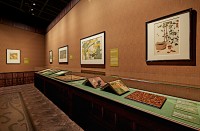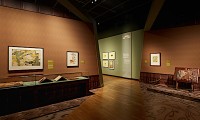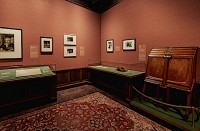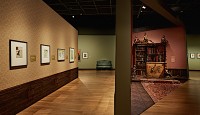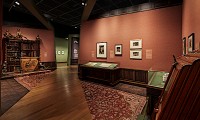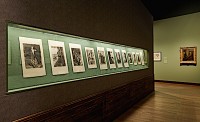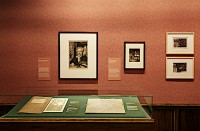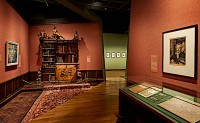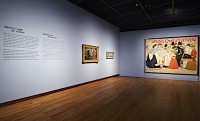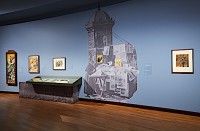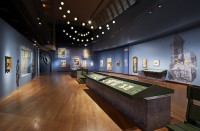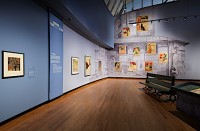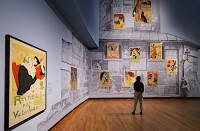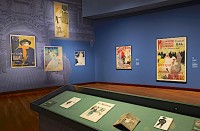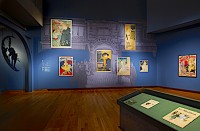The browser will either open the file, download it, or display a dialog.
Prints in Paris 1900: From Elite to the Street
Van Gogh Museum, Amsterdam
March 3, 2017–June 11, 2017
Mitsubishi Ichigokan Museum, Tokyo
October 17, 2017–January 17, 2018
Catalogue:
Fleur Roos Rosa de Carvalho.
Prints in Paris 1900: From Elite to the Street.
New Haven: Yale University Press, 2017.
192 pp.; 160 color and 25 b&w illus.
$50.
ISBN: 9780300229134
After a lengthy and exhaustive viewing of the recent Van Gogh Museum exhibition and after careful reading of the catalogue for the exhibition, it is time to assess what the exhibition achieved (figs. 1, 2). The organization of this show, the various sections of the catalogue, and the immersion in the creative reconstruction of the print world in 1900 make it easier for print historians, and print lovers, to understand the medium and its history; this included a study of the immense popularity of prints at the time they were created, as well as the artists who created them, and the issues that concerned these artists at the time. To truly appreciate the achievements of the exhibition one had to see it, so in lieu of a firsthand viewing, it is imperative to give the readers of this review a clear and thorough survey of the installation, which was one of the most imaginative ever witnessed by this reviewer.
First we must note that this entire show and publication is one of overwhelming creativity and achievement; one that clearly reflects the ways in which curator Fleur Roos Rosa de Carvalho has nurtured the exhibition and the catalogue. Her work displays a scholarly awareness of creative printmaking in Paris in the later part of the nineteenth century, how these prints were produced, what they set out to say, and how the prints were shown, promoted, and sold at the time. Even though this grouping of prints in the Van Gogh Museum was not purchased in 1900, but only after the opening of the museum, they include most of the major printmakers’ efforts in etching, lithography, woodcuts, or photo mechanical reproduction. We learned about all of these major printmakers and how the prints were appreciated by connoisseurs for their own private enjoyment; some print aficionados even constructed private spaces where they could spend isolated hours in contemplation of their objects. The exhibition also revealed how portfolios of prints were produced for sale; occasionally print publications were completed with very creative cover designs that allowed other crafts, such as book design and binding, to reinforce the appreciation of the prints (figs. 3, 4, 5, 6). The exhibition also clarified that many prints were made for a larger public who saw these images posted on kiosks and city walls. There, they served the function of advertising the widest variety of products, events, and performers, especially in posters plastered throughout certain sections of the city. Advertisements were elevated to the status of art; performers achieved their notoriety through posters, and the creation of a celebrity culture was advanced. These posters, as shown in the installation, proliferated everywhere. Combined with the wide availability of magazines that reproduced prints, people were overwhelmed by the profusion of art images similar to what has happened with the internet in our time.
To understand why certain prints were selected for inclusion in the exhibition, it is essential that we review, albeit briefly, some of the major strategies outlined by Roos Rosa de Carvalho in her catalogue and in the exhibition wall texts that accompany many of the prints. Accepting that there were two simultaneous tendencies at work during the print renaissance of the nineteenth century (prints for an elite and images destined for the street) provided Roos Rosa de Carvalho with a convenient way to grasp the entire print movement. By acknowledging that there was a group of connoisseurs/collectors who appreciated and supported the etching renaissance beginning in the 1860s, the curator highlighted the importance of the private amateur as someone whose acquisitive nature elevated the appreciation of prints while stressing the concept of the beautiful impression, the perfect image that was sought by the most fervent collectors. Whether these print collectors were individuals such as Philippe Burty—an avid collector and art critic who, in my estimation does not receive the attention he deserves in the show—or the writers/connoisseurs Edmond de Goncourt and Roger Marx, the role of these men remains a constant. Roos Rosa de Carvalho ably points out in the catalogue, as well as in the exhibition, that etchings (and some lithographs) were created for private contemplation. The design of the exhibition reinforces this attitude by creating small rooms that suggest the intimacy of private print connoisseurship. A quality of meditation is nicely underscored in these spaces from the range of prints occasionally abetted by famous prints such as the one by Félix Bracquemond of Edmond de Goncourt smoking in the midst of a portfolio of prints by his brother Jules and a Japanese art object (fig. 7).
These collectors were part of the visual elite that wanted to keep these prints for themselves (although some expressed the need to reach a larger audience) to be viewed in the quiet of their secluded rooms; they were stored in specially made print cabinets or portfolios safely away from potentially damaging light. Pieces of furniture designed by Rupert Carabin or Eugène Gaillard were brilliantly included in the installation, creatively evoking the ways in which these prints were seen, preserved, and stored (figs. 8, 9). The superb series of etchings by Albert Besnard, on the theme of women (La Femme, 1886–87), displays the consequences of illicit love, child bearing outside the family unit, in a graphically realistic manner that also symbolically suggests the condition of women in general in a manner that is elusive, personal, and in some images deeply felt (fig. 10). These are the type of prints that were much appreciated by print collectors although they were not destined for broad public awareness (figs. 11, 12).
The other side of this superb survey of printmaking displays the posters created for a large public including merchants, promoters of events, celebrities that needed attention, and all manner of products. These enterprises wanted to attract a solid audience by using the persuasive visual talent of artists they employed. Contrasting sharply with the role of the elite in collecting prints were examples of far more colorful lithographs that were destined for exhibition on the streets of Paris where their compositions had to be understood by a passing audience from a distance. These large images were often found on walls or special advertising columns known as Morris columns. While often thought of as ephemera, they were nonetheless collected either by people who dared to wrench them directly from the walls or bought them directly from the artists, or more likely, from the printers who produced the images (figs. 13, 14). While many of these works were intended for commercial dissemination, the fact that they were preserved by collectors and dealers demonstrates that they also were seen as aesthetic art objects. As Dennis Cate has noted in his publications on this period, many of the lithographs were part of an extensive color revolution in printing, a movement that has been well chronicled by scholars. Roos Rosa de Carvalho smartly introduced them in a later section of the installation to show that all prints—including lithographs—constituted a unified artistic movement (fig. 15).
Because the organizers of the exhibition were conscious that visitors either were totally unfamiliar with, or uninterested in, prints, they realized that the scenography of the exhibition was of singular importance. They also took great pains to provide carefully written wall texts that helped explain the development of the print medium in the nineteenth century, as well as the most important artists, dealers, and collectors. In addition, the curator and the designer prepared a detailed dossier of how the show was to appear on the walls of the Van Gogh Museum. Each section of the show was itemized, every example carefully integrated into the spaces that were to be constructed, from the sections for contemplation of individual prints or print series in collectors’ private rooms to the ways posters were found everywhere on Parisian buildings (fig. 16).
The organization of the show, presented with a bird’s eye view of the various sections, emphasized the intimacy created in the gallery spaces dedicated to the elites. Each area with etchings was controlled, with parquet paneling on the floor, and the suggestion in some cases of richly woven carpets, done to show the viewer that these were the rooms of wealthy individuals who created an environment especially for the appreciation of small prints and books. The effect was startling. Even the utilization of portfolios reinforced the way in which the prints were examined, stressing the close viewing given to the etchings. The fact that there were pieces of art nouveau furniture that had been created expressly for the preservation of prints brings home the seriousness of this print movement.
As the exhibition moved to the second floor of the Van Gogh Museum, a sense of expansiveness was presented. One had the opportunity to see how posters were displayed on kiosks or on the walls of various buildings although this was not easily apparent unless a viewer moved to the third floor of the exhibition where there was a bird’s-eye viewpoint of one section of the lithographs on the walls of buildings (fig. 17). The opportunity for a visitor to pick up a facsimile of an actual publication of the time provided one other way in which viewers’ involvement was enhanced by suggesting that the wide availability of the magazines of the era were everywhere. It was no surprise to see that the large scale lithograph by Théophile Steinlen, La Rue, was used to document one of the publishers of posters, Charles Verneau, who hoped to reach as many passersby as possible with an appealing image (see fig. 13).
Nothing was left to chance by the organizers of the show. Formulating the exhibition ahead of time gave the organizers the opportunity to see how the ideas behind the show were to be communicated on the walls of the Van Gogh Museum. Intellectually, visually, historically, most of the pertinent ways in which the reconstruction of the print environment in 1900 were conveyed was overwhelming. Any visitor to this exhibition could not fail to remember the outstanding care expended on its design, and in the process, gain a new respect for the world of prints.
Occasionally positioned in the exhibition were pieces of furniture that were used to creatively show how prints were preserved by collectors and meticulously studied. These pieces dedicated to the preservation of prints and books highlight the revolution in the decorative arts that was sweeping the Parisian art world in 1900. The applied arts under designers such as Rupert Carabin, Eugène Gaillard, and others demonstrated that all the applied arts (with prints, being seen as an extension of this direction, becoming significant art objects themselves) were part of a period of efflorescence that culminated in both the Symbolist and the Art Nouveau movements. These additions to the installation, although not stressed in the catalogue, were a very significant part of the show as they highlighted the interconnection of all the arts in the period under investigation. Why is this so significant we must ask?
Large-scale exhibitions, not simply shows within the confines of an art dealer’s gallery such as Siegfried Bing, Ambrose Vollard, or Le Barc de Boutteville, were demonstrating that prints were very significant aesthetic objects. By 1900, the Salons of the Société Nationale des Beaux-Arts demonstrated that prints were to be seen on an equal footing with all other established artistic categories such as painting or sculpture. Roos Rosa de Carvalho tried to reinforce this idea by pointing the viewer toward the concept of the unification of all the arts—the total package of art objects working in unison with one another. This is, perhaps, one area of the exhibition that could have been enlarged upon, but which we are sure will be the direction of new studies and exhibitions in the future. There is much fertile territory to be mined in the world of prints; this exhibition presents a foundation that can be built upon in years to come.
Although the exhibition was a mammoth one, a show where visitors could select favorites from a vast panoply of significant images, the contribution of the exhibition is complex (figs. 18, 19). On one level, Roos Rosa de Carvalho has demonstrated that there is a new way to look at and interpret prints by reconstructing how they were appreciated by artists, collectors, dealers, and the general public at the time the works were created. She also abandoned the traditional way in which prints were to be exhibited in a museum by reconstructing how the prints were seen in 1900. More than this, she argued for creative ways in which prints can be shown in a museum exhibition by working carefully with talented designers who evoked the historical world she was entering. To perpetuate this idea, the installation at the Van Gogh Museum (the only European venue for this show) needs to be preserved online so that future print curators can experience what was meticulously done here. Installation and objects belong together, even the design of the catalogue pales in comparison with what was achieved in the show itself. Roos Rosa de Carvalho must be warmly complimented for what she has achieved, as this exhibition frees the print world from cumbersome traditional ways of thinking about and exhibiting prints. The result is one of total liberation and admiration that this could be effectively done in a way that encourages visitors to return and continue to absorb the innovations in the design of the exhibition; and to examine individual prints in the context of the locations where they were first seen, either in rooms of personal connoisseurship or on the streets and walls of an urbanized center—Paris.
Gabriel P. Weisberg
Professor Emeritus, University of Minnesota
vooni1942[at]aol.com


